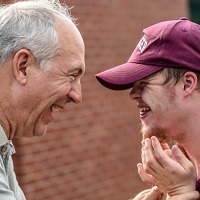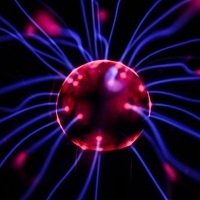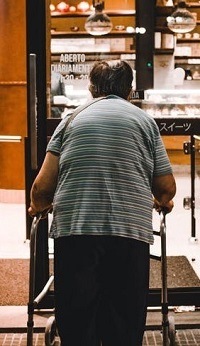 In this post you will find the answer to the question “what is music therapy and how does it work?” We will look at 3 different types of music therapy, we will find out how music therapy has developed in recent years, who can benefit from it and we can begin to understand some of the processes involved in healing with music.
In this post you will find the answer to the question “what is music therapy and how does it work?” We will look at 3 different types of music therapy, we will find out how music therapy has developed in recent years, who can benefit from it and we can begin to understand some of the processes involved in healing with music.
So, without further ado…
The Nordoff Robbins Approach
One of the most influential collaborations in the field of music therapy was that of Nordoff and Robbins. Paul Nordoff was an American Composer and Music Therapist. Clive Robbins was a British Music Therapist and Special Needs Teacher.
They began working together in 1958, and developed their approach to creative music therapy over a period of 17 years. Initially working with hard to reach kids with psychological, physical and developmental disabilities, the approach they used was based on the belief that each of us has the ability to be touched by music.
The aim of the therapy was to give their clients a means by which to express themselves through making music together. Some of these children had never spoken before. Some had never shown any kind of emotional response until music was introduced to them.
So how did it work? The therapist(s) played different music and instruments to the children who were encouraged to join in. Each session was videoed and subject to in-depth analysis afterwards in order to plan the following sessions and recognise improvements as they happened.
Things didn’t happen overnight, but with continued perseverance, assessment and session adaptation, Nordoff, Robbins and their clients achieved some astounding results and the clients began to respond by singing, playing the instruments and moving to the music. You have to see it to believe it! Here’s a link to a YouTube video from some of their earlier work….
The sessions featured here didn’t “cure” children. What they did do was bring joy and laughter, improve communication and motivation, improve motor skills, posture and so much more. I’ve watched a lot of footage of Nordoff Robbins and each time it brings a tear to my eye. I am in complete awe of the founders of this approach, and also of the therapists who continue this amazing work.
Today this approach lives on and Nordoff Robbins is the largest independent music therapy charity in the U.K. Each music therapist must successfully complete the 2-year Master of Music Therapy programme to enable them to work so expertly with children and adults who have such a wide range of issues and challenges from neurological disorders, emotional difficulties and behavioural issues to working with cancer patients and those in geriatric care.
These therapists have touched the lives of so many by making music together with their clients. They have helped children to speak for the first time, have unlocked memories for dementia sufferers, have helped stroke or accident victims to walk and talk again, have bought joy and happiness to those suffering with depression. The list goes on.
The technique is delivered globally, and across the U.K. the charity works with over 200 partner organisations including schools, hospitals and rehabilitation centres. Of the U.K. centres, 15 of them offer free sessions and in 2018 the charity supported over 10,000 people.
The Nordoff Robbins mission is “to provide music therapy to anyone whose quality of life could be improved by it.” As quoted from the website, “92% of people who had music therapy with us said it improved their quality of life” and “95% said it improved their communication skills.”
 If you would like to learn more about Nordoff Robbins music therapy for yourself or a loved one, or to find out about the Nordoff Robbins Master of Music Therapy Program or PhD, or if you would like to make a donation, you can visit the website here.
If you would like to learn more about Nordoff Robbins music therapy for yourself or a loved one, or to find out about the Nordoff Robbins Master of Music Therapy Program or PhD, or if you would like to make a donation, you can visit the website here.
There are also more videos of the music therapists and clients in action. Their work is truly amazing.
The Bonny Method of G. I. M.
G.I.M. is Guided Imagery and Music and the Bonny Method was founded in the 1970’s by American musician and psychotherapist Helen L. Bonny. What does it do? It helps to release emotions from past trauma, painful memories, relationship issues, underlying reasons for illness and so on.
The practitioner and client will initially consult to discuss the reason for the therapy, to identify goals and desired outcomes and to formulate a programme. When the programme begins, each session starts with an agreement on what that particular session will focus on i.e. which one area needs addressing or which question needs answering.
The patient will then enter into a relaxed state, in a recliner or laying down with the eyes closed. Music is then played for 30-45 minutes, usually a classical recording, and the therapist will start by introducing a previously agreed image.
This is where the inner work begins; as the client forms the image – visually or otherwise – they begin to respond to the music. They might experience this physically, emotionally or spiritually. Their deep consciousness might evoke memories, inspiration, intuition etc.
 The intention is for the patient to immerse themselves into and connect deeply with the music, allowing the unconscious to take over and find the “answers” to the question i.e. to discover what tools and resources can be best used to deal with the issue at hand.
The intention is for the patient to immerse themselves into and connect deeply with the music, allowing the unconscious to take over and find the “answers” to the question i.e. to discover what tools and resources can be best used to deal with the issue at hand.
The facilitator uses suggestions to assist the client to immerse themselves further, but the key here is that they guide the experience – they do not direct it. The healing process should be the patient’s own and it’s important that they find within themselves the solutions they need and ways to work on their issues.
The client is encouraged to discuss their thoughts throughout the session and the practitioner will take notes. When the music stops playing, the session continues with discussion, psychoanalysis and sometimes drawing or other creative expression. The actual experience can be very healing, and this healing can continue after the session on an unconscious level.
The full session can last for upto 2 hours and is repeated every 2-3 weeks.
So does it work? According to a review by the Appalachian State University and the Rockford Center :
“Evidence is promising that a series of Bonny Method of G.I.M. sessions may be effective for improving both psychological and physiological health and may be therapeutically indicated for adults seeking treatment with medical, mental health, and nonclinical needs. Further research is needed to replicate findings within outcomes and populations.”
For details of a practitioner near you, click here for a direct link to the Association for Music and Imagery web directory.
Neurologic Music Therapy (N.M.T.)
Traditional music therapy is used to improve general wellbeing through social activities which in turn have a positive effect on physical, mental and emotional health. More recently developed, N.M.T. is different in that it’s based on neuroscience i.e. the study of how neurons work.
 We know that music enhances neuroplasticity. This is where our brain structure changes according to our experiences; when we carry out new actions, new neural pathways or connections are created. In order for this to happen, 2 neurons must fire together. When they do a path is created where signals can travel to and from the brain in order for us to perform the task at hand.
We know that music enhances neuroplasticity. This is where our brain structure changes according to our experiences; when we carry out new actions, new neural pathways or connections are created. In order for this to happen, 2 neurons must fire together. When they do a path is created where signals can travel to and from the brain in order for us to perform the task at hand.
When we practice these actions, our neural pathways get stronger. Vice versa, when we don’t practice an action the pathways get weaker. So by practicing an action we get better at it. When we practice it and repeat it enough, our brain changes and these new actions become the “norm.” This can be used to help stroke victims learn to walk and talk again for example.
Music also increases the amount of dopamine that the brain produces. Dopamine is a neurotransmitter – that means it sends signals between the body and the brain. This “messenger” is usually released during activities that we enjoy, such as eating or exercising, and is linked to movement and emotions.
However, some people have extremely low levels of this chemical. N.M.T. can help to increase these levels which is especially beneficial to those challenged with Pakinson’s or ADHD.
This is such a vast subject and there are so many ways N.M.T. can be used to help those with neurologic injury or disease. These are broken down into 3 main areas as follows, along with examples of what each particular type of therapy involves :
For activities involving sensory and motor functions
- rhythm is used to improve how a client walks by stimulating the brain to send signals to the motor system
- different elements of music (e.g. rhythm, melody) are used to improve the performance of daily activities such as sitting down and standing up
- musical instruments are played to improve dexterity and co-ordination
(These techniques are used predominantly with stroke victims.)
To improve speech and language
- songs, rhymes and chants are used to improve and stimulate speech
- rhythm is used to control the rate of speech
- vocal exercises e.g. singing scales, are used to train pitch and breath control
- exercises using vocals and wind instruments are used to improve articulation and to strengthen the respiratory system
- structured or improvisational performance is used to train a number of areas including social interaction and emotional communication
(These techniques are used for aphasia, apraxia and stroke victims.)
For cognitive rehabilitation
- live or recorded music is used to encourage reactions, awareness and attention
- the use of time, tempo and rhythm through playing instruments to improve sensory neglect
- musical exercises are used to help identify different aspects of sound and to improve memory and recall
- using structured and improvisational exercises to improve skills including problem solving, decision-making and reasoning.
(These techniques are used for brain injury, psychiatric disorders, dementia and autism.)
 A typical session will last for an hour and is facilitated by a specialist N.M.T. therapist. Music affects each part of the brain and the therapists are expertly trained to know which areas of the brain need work. They will then design and implement the correct training plan to stimulate these areas in order to improve speech, movement, expression and so on.
A typical session will last for an hour and is facilitated by a specialist N.M.T. therapist. Music affects each part of the brain and the therapists are expertly trained to know which areas of the brain need work. They will then design and implement the correct training plan to stimulate these areas in order to improve speech, movement, expression and so on.
If, like me, you find this subject fascinating visit the Academy of Neurologic Music Therapy website for further information. You will also find a directory of worldwide practitioners on the site, as well as how to train as a Neurologic Music Therapist.
Conclusion
From reading the above you will have an idea of 3 quite different types of music therapy and what you could expect from each – whether in a session, as an outcome or as a practitioner. To me, the work of a music therapist is awe-inspiring, as is the dedication and perseverance of the clients they work with.
“Good health” is something most of us take for granted. When you look a little deeper and understand the difficulties people face on a day to day basis, you begin to realise how lucky you are – to be able to walk and talk, to be able to express yourself, to be able to just be without having to learn these skills for the first time. Or to have to re-learn them if you have a stroke, car accident, aneurysm and so on.
I hope you have enjoyed this article. Please share it with friends or loved ones to spread the word about this amazing work. If you have any comments, please leave them in the box below.
For other articles in the sound healing series, click on the following links…Binaural Beats Therapy, Sound Bath Therapy, Music and Sound Healing Courses.




